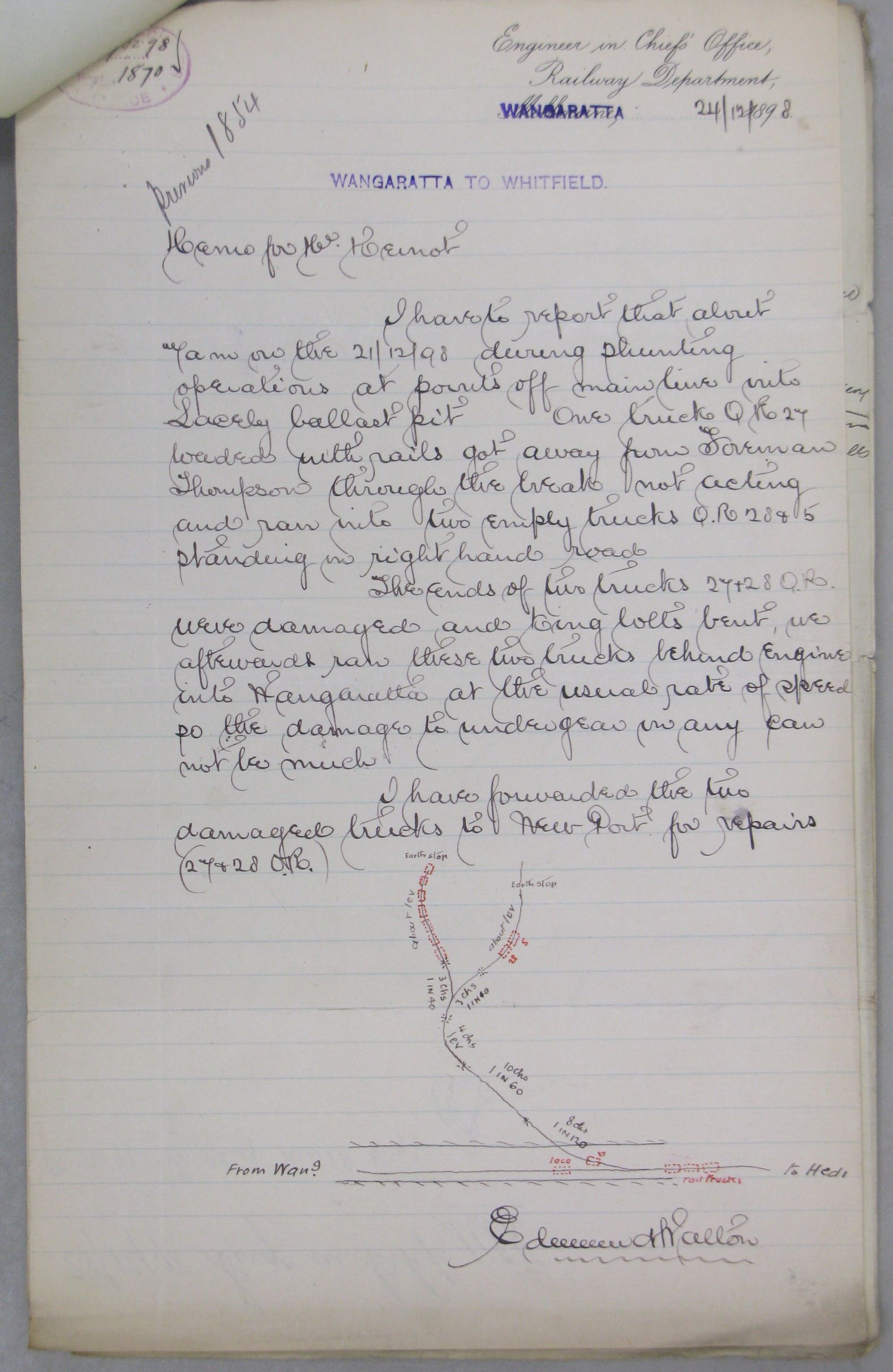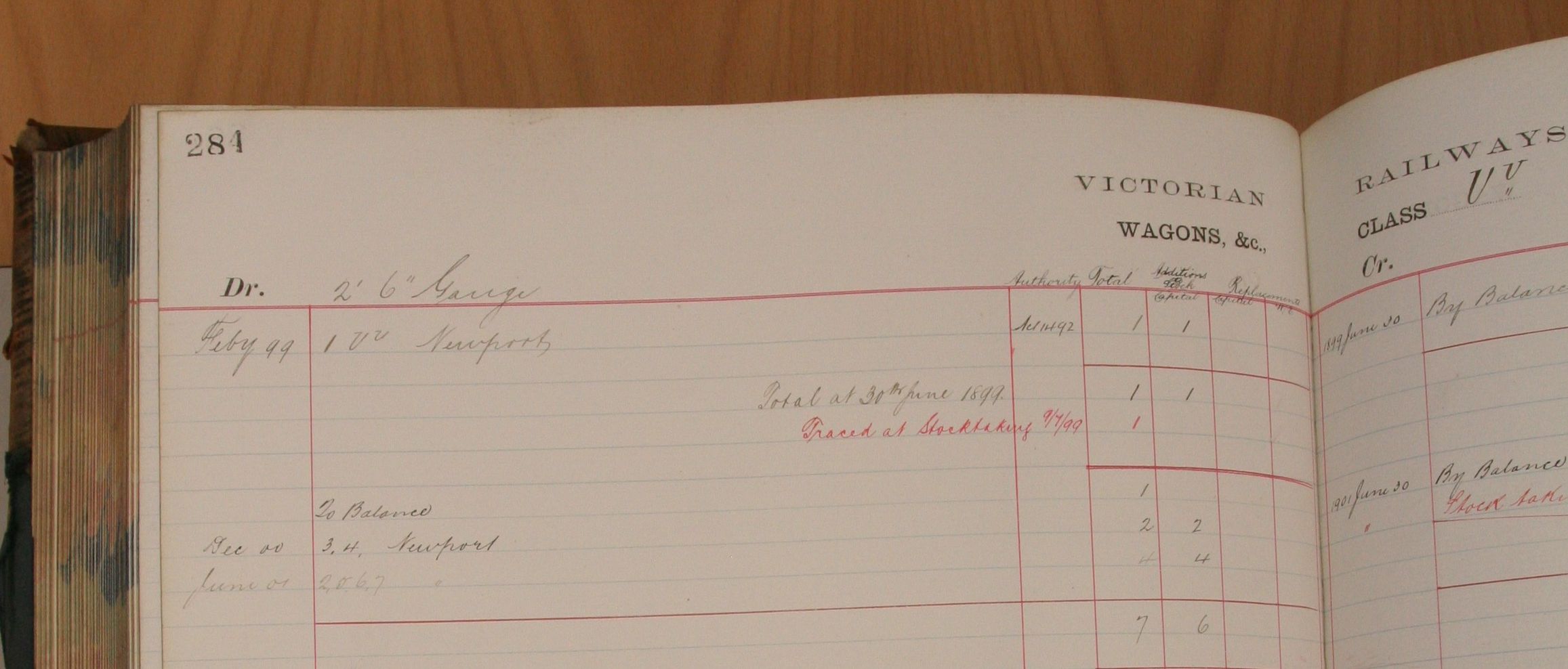1899 Narrow Gauge Recoding1
It has always been assumed that the prefix 'N' on the narrow gauge codes
had been applied since the start of the narrow gauge running. However
information and inspection of official records has revealed that this may
not be the case.
This investigation also answers a question in regard to the engines that
ran on the 2'6" lines. The locomotives had number plates with 'A' but were
referred to as 'NA'. This was alluded to in the publication
'Speed Limit 20' but no details given.
The information currently determined is itemized below in the hope that
more information may come forward as more research is conducted. Note:
'XX' is used to represent various class letters.
- The headings given in the official 'Rolling Stock Register' for the
rolling stock show XX 2'6" Narrow Gauge where XX is the class.
The class letters given clearly show the letter N is appended at a later
date. This may be a minor point but the doubt initially raised by the
author was 'Why describe the gauge of the stock when the class letters
do so?'. This is shown by the code being written by the clerk centrally
down the respective column for the initial wagons but at a later date,
the prefix + code has been written centrally down the column with the
early records being appended with an "N" to the left of the written
code, ie not constrained within the column lines.Hardly a clerical
"error" given that the era of clerical work demanded accuracy and
penmanship. Perusal of these entries show that history is not about
"recording the data" but understanding how the data was written.
- Official documentation photographed by Daryl Gregory shows the narrow
guage UU page. Other pages have been photographed for the other classes.
- Annual Reports between 1900 and 1905 show narrow gauge codes as either
XX or NXX. This shows that a change was made but there was
confusion when information may have not been passed on. The author
raises the point that if the classes were always known with a prefix
there would be no mix-up. Broad gauge and narrow gauge codes are
represented in different tables.
- A locomotive outline diagram for the 'NA' class was found
with a date of 1900. The diagram is headed simply 'A', no prefix 'N'.
The 'A' is centred on the page which indicates that that was the only
letter used; no letters have been removed. There were many steps taken
to arrive at a diagram; from the drafting room and colation of the asset
Registers ( which is what the Rolling Stock Registers really are ).
- Correspondence from Victorian Railways to the New Zealand Railways in
1902 indicates the prefix 'N' on all codes in use. New Zealand was
interested in the 2'6" gauge lines and had requested the VR for
information.
- The 1904 Diagram Books show the prefix 'N' in use on all classes. The
same 'A' diagram as mentioned above had the prefix 'N' added to the
class letter. This would explain why the loco number plates are cast
with a single 'A', yet the class known as 'NA'; "N" being a
reference to the class NOT
'Insert number here'. With knowledge of internal working, the recasting
of loco number plates to show the prefix 'N' would have been considered
expensive and not warranted. Particularly when the lines were not
profitable and the change would be cosmetic in nature. A.E.Downs in his
book 'Speed Limit 20' makes passing reference to the fact that the
locomotives entered service as 'A' but "...they later became known as
the NA class...".
- Photographs of some carriage rolling stock between 1900 and 1912 show
the prefix 'N' in most unusual places. This is generally an indication
of lettering being added after the main letters have been
painted on. Photographs show that this lettering 'style' was copied when
the recoding was done in 1910. By unusual for example the lettering 'N1ABAB'
or 1910 relettering such as 'N7B' is interpreted by the author as
evidence of additional lettering after
the main lettering has been applied. No class lettering is split with a
number in the middle. Unless the original lettering of '1ABAB' has
had the letter 'N' appended as a prefix and there was lack of space
between the '1' and the 'A'. As for NB 7 ( photographed as N7B ),
it was not built until 1906, the lettering defies explanation. UNLESS
one understands the methodology of how wagons and rolling stock
are dated. Until a wagon or rolling stock item leaves the workshops and
is placed "on the line", it may have a class and number but will not be
recorded in the asset register. Once ready for service and leaves the
workshops it is recorded as an asset. So perhaps NB 7 was built earlier
for traffic and originally lettered but never entered service until
1907. Some examples will help:
- OO wagons: 6 x built 1 x 1899, 5 x built 1902. Strange - the wagon
was was unsuccessful for what it was built for. So five more were
built in 1902, some three years later? Maybe not. Lets assume six were
built in 1899-1900. The failure of the first prevented the other
wagons going into traffic and until some traffic use was found, they
languished at Newport.
- Photographs in the VR Newsrail of rolling stock that was classed and
numbered but never entered service as the code was changed.
- Tait BT 201 was built from the carriage of the original 441T. The
'gap' in numbering was not filled for another two or three years.
- Correspondence for 1898 shows a derailment occurred at the Laceby
Ballast Pits ( near Wangaratta on the Whitfield line ) during line
construction. The wagons mentioned were three 'QR' wagons, no prefix 'N'
mentioned. The image below was supplied by Daryl Gregory, from
photographs by Matthew Walker. This image forms part of the
correspondence.

- Photographs of the official first train to Whitfield, March 1899, show
the use of the prefix 'N' on cars where the class and numbers can be
determined.
- Clerical records written at the time ( 1897 to about 1902 ) clearly
show the vehicles being 'written up' without the prefix 'N'. The
'N' has been added in at a later date ( see above )
From all of the above information the author is proposing a theory for
the possible change and an approximate date. The data cannot merely be
dismissed as mistakes or ignored. That is not research. The date seemed to
have been about 1902. The reason seems to be quite interesting.
The first narrow gauge line was isolated in the North East region of
Victoria. The codes adopted for the rolling stock were identical to broad
gauge equivalents. As the line was new and 'narrow gauge' the buzz of the
times it would have seemed that any call for parts or rolling stock
equipment from Wangaratta would obviously be 'narrow gauge'. The
two main depots for loco and rolling stock maintenance were Benalla and
Wodonga. Only Wangaratta would be servicing locomotives or rolling stock
and narrow gauge ones at that. The author postulated that perhaps with
other narrow gauge lines opening ( Colac, 1902 ), the terminal
facilities were shared by both broad and narrow gauge interests. A request
for 'QR' parts or loco 'A' equipment would immediately draw the response
'Broad or Narrow?'. Indeed, there are stories out of 'Puffing Billy' at
Belgrave that a mix-up did occur. No details, though. I reiterate, if the
coding was clearly defined there would be no mixup
However, the postulated date of 1902 did not hold as more data narrowed
the gap of early codes after 1897 and prefix 'N' codes before 1902 were
referenced.
The available data suggests that the prefix 'N' was not applied to stock
until the opening of the line to Whitfield and the running of the first official
train. This means that during the line construction the rolling stock
codes were as for broad gauge; ABAB, QR, Loco A, etc. It appears that
close to line opening date in March 1899, the classes of rolling stock
were hastily altered to show a prefix 'N'. Perhaps the mix ups or
incorrect equipment deliveries to maintain rolling stock would have been a
logical 'trigger' to generate the change.
Until more data comes to hand, a more accurate relettering date is not
available. On that basis these pages are a provisional history and a full
history will never be known. A history of the NG is not complete unless
the outstanding unknowns are also mentioned. To not mention this
information is a dis-service to readers who will assume that the history
is clearly defined.
Sources:
- Public Records Office, Railway correspondence 1898, 1902
- 1897 Diagram Book and amendments
- 'Speed Limit 20' by A.E.Downs, 1963 print
- 1904 Diagrams Book
- 1886 'Register' entries
- Paste up originals of Annual Reports, c1900 - 1902
- Photographs of the era
- Mathew Walker photographs of correspondence
This research was triggered by the research efforts of Rob O'Regan who
questioned some information and had a history of clerical work background
and an understanding of accuracy.
Notes:
- I have used 1899 as a starting point
for the page to provoke discussion and further research
- In the interest of continuity I have
presented the narrow guage rolling stock histories in my database as
if the prefix N was at the introduction of the lines.
- The data and notes are presented to
show 'something' happened. The story has not yet been told.
File m1899m compiled by Peter J. Vincent, updated 23/11/2018

